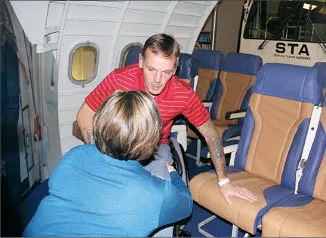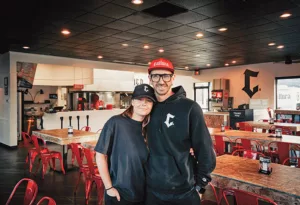
Home » Rehabilitation facility brings transit indoors
Rehabilitation facility brings transit indoors
Airplane hull installed last summer is newest therapy module

November 21, 2012
Paul Swanson, a patient at St. Luke's Rehabilitation Institute, and his physical therapist talk through each step of the process it takes to transfer from a wheelchair to the passenger seat of the nearby car. Ten feet away sits part of an airplane hull built for practicing a similar transfer, Swanson's next stop.
Both modules are located in St. Luke's Community, a 2,200-square-foot real-world simulation facility inside the rehabilitation hospital, at 715 S. Cowley, that enables patients to practice every day tasks, like car transfers and shopping at a grocery store, in a closed environment.
"We now better prepare people to leave," says Chris Clutter, physical therapist and inpatient therapy manager for St. Luke's.
The facility helps patients who have mobility issues due to injury or illness, like Swanson who has multiple sclerosis, an autoimmune disease that affects the central nervous system. Therapists can use the facility for a number of rehabilitation purposes, including patients who have sight impairments or a cognitive disability, Clutter says.
"Almost all the (long-term) patients come at least once during their stay," she says.
Nicole Stewart, director of marketing and communications for Inland Northwest Health Services, which operates the rehabilitation hospital, says St. Luke's employs 435 full-time employees and works with about 7,000 patients each year, offering both inpatient and outpatient services.
Clutter says the community space receives 300 patient visits per month. Stewart says there are a handful of therapy spaces similar to St. Luke's Community, but she believes the closest one is at Northwest Hospital & Medical Center, in Seattle.
St. Luke's Community has been operating since November 2010, and St. Luke's added a Southwest Airlines airplane module in July, Stewart says.
The plane module is a portion of an airplane hull with seats. The plane, like St. Luke's other transportation modules—including a car, a sport utility vehicle, and a bus—allow patients at St. Luke's to practice mobility in a safer environment, Clutter says.
"People don't go home and stay home," she says. "Everyone has to shop."
Prior to the therapy space being built, Clutter says, therapists still performed mobility exercises with patients, but this space enables patients to draw more easily the connection between what they practice in therapy and what they need to do on a daily basis once they leave.
"If you're just doing these things and you don't understand how it relates, you don't understand the motivation," Clutter says.
To practice a plane transfer from a wheelchair to a seat, patients would have to go to the airport and practice on one of the planes. Even transfer practices that could be completed onsite, like a car transfer, pose their own challenges when the weather turns bad.
Each module was donated by a company or agency. For example, Spokane Transit Authority donated the bus module, and Tomato Street donated a restaurant module. The space includes mockups of locations like a bank, a store with a check stand, an office, and an ATM in addition to the transportation space.
Swanson saw the rehabilitation space being built during his first stay at the institute two years ago. He says at that time construction crews were just starting to build the walls. Now, during his second stay, Swanson often has therapy sessions in the St. Luke's Community space.
Sarah Gross, Swanson's physical therapist, says, "He's learning a ton of new techniques."
Swanson, who practiced on the plane and bus for the first time, says practicing mobility at St. Luke's Community takes away some of the fear and judgment that would otherwise come with practicing out in the community.
"If I was to be put on a plane, I wouldn't have flown," Swanson says. "I'm scared of falling, of missing my seat."
Swanson's feelings are echoed by the therapists, who say the facility enables patients to practice in a closed environment while being as safe as possible.
Clutter says the facility helps therapists maximize time with patients during physical-therapy sessions. She says physical therapists get together and fine-tune physical therapy plans. For example, with the modules, it's easy for physical therapists to create a mobility obstacle course, she says.
"It makes it real easy for the therapists who may only have 30 minutes (with an individual patient)," she says.
For Swanson, who is learning how to use a wheelchair, the physical therapy staff at St. Luke's educates patients on how to go about living safely day to day, but to do that, they need to break down barriers that he says patients often put up when they first show up at the facility. He says when he first came to the institute, he thought he knew it all and was afraid. The therapists, who he calls his warriors, helped him combat that fear.
"What they gave me was a way to live," Swanson says. "With the tools they're giving me, I'm going to rock it."
Up Close
Related Articles



_web.webp?t=1764835652)